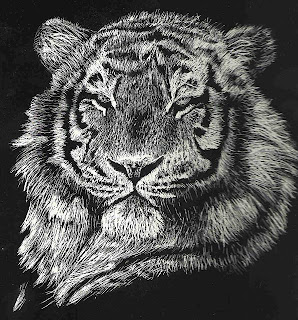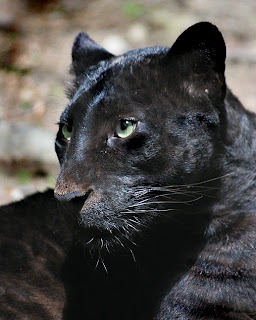It is under the biological family: Felidae, in layman terms, the cat family.
 There are 40 known species of felids in the world today.
There are 40 known species of felids in the world today.Extant felids belong one of the two sub-families: Felinae and Pantherinae.
Under Felinae, there are Genus Prionailurus, Puma, Acinonyx, Lynx, Leopardus, Leptailurus, Caracal, Profelis, Catopuma and Pardofelis.
Under Pantherinae, there are Genus Neofelis, Panthera and Uncia.
However, I am just going to feature some the prominent ones.
First, lets talk about one that is already extinct.
 Smilodon剑齿虎, also known as saber-toothed tiger.
Smilodon剑齿虎, also known as saber-toothed tiger.They belong to an extinct genus of large machairodontine saber-toothed cats.
They possess extremely long maxillary canines.
They became extinct around 10,000 BC.
It is hypothesised that their extinction is due to the end of the ice age.
Nowadays, you can still see them actually.
But where? In the museum,
In this form:

Next in the list, the King Of JUngle, lion (Panthera leo), one of the four species of big cats under Genus Panthera.
 Eight subspecies of it is recognized today.
Eight subspecies of it is recognized today.They are the tallest of the felines.
They are predatory carnivores who manifest two types of social organization.
Some are residents, living in groups, called prides.
Some are labeled nomads, who range widely and move about sporadically, either singularly or in pairs.
Lion sounds include snarling, purring, hissing, coughing, miaowing, woofing and roaring.
They most often roar at night; the sound, which can be heard from a distance of 8 kilometres, is used to advertise the animal's presence.
Singapore derives her name from lion, in malay, Singa.
Given by a fourteenth century Sumatran Malay prince named Sang Nila Utama, who alighting the island after a thunderstorm, spotted an auspicious beast on shore that his chief minister identified as a lion.
However, recent studies shows that lions have never lived there, so the beast that he saw was most likely a tiger instead=)
Another species under Genus Panthera is the tiger (Panthera tigris).
 They are the heaviest cats.
They are the heaviest cats.Reaching up to 4 metres (13 ft) in total length and weighing up to 300 kilograms (660 pounds).
The pattern of their stripes is unique to each animal, and thus could potentially be used to identify individuals, much in the same way as fingerprints are used to identify people.
Recently, there are nine subspecies of tigers.
 In my opinion, Sumatran tigers are the most handsome tigers out of the nine subspecies.
In my opinion, Sumatran tigers are the most handsome tigers out of the nine subspecies.In a poll conducted by Animal Planet, the Tiger was voted the world's favourite animal, narrowly beating man's best friend, the dog.
Third species under Genus Panthera is the jaguar (Panthera onca).
 It is strongly associated with the presence of water and is notable, along with the tiger, as a feline that enjoys swimming.
It is strongly associated with the presence of water and is notable, along with the tiger, as a feline that enjoys swimming.The jaguar is a largely solitary, stalk-and-ambush predator, and is opportunistic in prey selection.
They have developed an exceptionally powerful bite, even relative to the other big cats.
This allows them to pierce the shells of armoured reptiles and to employ an unusual killing method: it bites directly through the skull of prey between the ears to deliver a fatal blow to the brain.
Like most cats, the jaguar is solitary outside mother-cub groups.
Lastly under Genus Panthera is the leopard (Panthera pardus).
 The smallest of the four roaring cats.
The smallest of the four roaring cats.The leopard has relatively short legs and a long body, with a large skull.
Physically, it most closely resembles the jaguar, although it is usually smaller and of slighter build.
Its fur is marked with rosettes which lack internal spots, unlike those of the jaguar.
The rosettes on a jaguar's coat are larger, fewer in number, usually darker, and have thicker lines and small spots in the middle that the leopard lacks.
Jaguars also have rounder heads and shorter, stockier limbs compared to leopards.
The leopard is an agile and stealthy predator.
They are known for their ability in climbing, and it has been observed resting on tree branches during the day and descending from trees headfirst.
The leopard is primarily a nocturnal creature, and many of its operations are done by night.
This is to avoid other competing large predators.
Now, here comes my favourite animal:
 Cheetah (Acinonyx jubatus)
Cheetah (Acinonyx jubatus)Why so?
1) Unique due to its speed
 It is the fastest land animal, reaching speeds between 112 and 120 km/h (70 and 75 mph)[3] in short bursts covering distances up to 460 m (1,500 ft), and has the ability to accelerate from 0 to 110 km/h (68 mph) in three seconds, greater than most supercars.
It is the fastest land animal, reaching speeds between 112 and 120 km/h (70 and 75 mph)[3] in short bursts covering distances up to 460 m (1,500 ft), and has the ability to accelerate from 0 to 110 km/h (68 mph) in three seconds, greater than most supercars.It lacks climbing abilities though.
The cheetah's paws have semi-retractable claws (known only in three other cat species - the Fishing Cat, the Flat-headed Cat and the Iriomote Cat) offering the cat extra grip in its high-speed pursuits.
Adaptations that enable the cheetah to run as fast as it does include large nostrils that allow for increased oxygen intake, and an enlarged heart and lungs that work together to circulate oxygen efficiently.
Cheetah also uses its tail as a rudder-like means of steering to allow it to make sharp turns, necessary to outflank prey who often make such turns to escape.
2) Beautiful skin
 The coarse, short fur of the cheetah is tan with round black spots measuring from 2 to 3 cm (0.79 to 1.2 in) across, affording it some camouflage while hunting.
The coarse, short fur of the cheetah is tan with round black spots measuring from 2 to 3 cm (0.79 to 1.2 in) across, affording it some camouflage while hunting.There are no spots on its white underside, but the tail has spots, which merge to form four to six dark rings at the end.
The tail usually ends in a bushy white tuft.
3) Slim body and striking features
 Look at her legs...
Look at her legs...The cheetah has a small head with high-set eyes.
Black "tear marks" run from the corner of its eyes down the sides of the nose to its mouth to keep sunlight out of its eyes and to aid in hunting and seeing long distances.
The cheetah's chest is deep and its waist is narrow.
4) It looks more humble.
 If you ask me why choose cheetah over jaguar or leopard, I must say that cheetah has a more humble look, unlike jaguar and leopard that look much like a tiger=)
If you ask me why choose cheetah over jaguar or leopard, I must say that cheetah has a more humble look, unlike jaguar and leopard that look much like a tiger=)5) They have cute cubs:
 Other facts:
Other facts:Unlike "true" big cats, the cheetah can purr as it inhales, but cannot roar.
By contrast, the big cats can roar but cannot purr, except while exhaling.
Males are very sociable and will group together for life, usually with their brothers in the same litter; although if a cub is the only male in the litter then two or three lone males may group up, or a lone male may join an existing group. These groups are called coalitions.
However, females always hunt alone, although cubs will accompany their mothers to learn to hunt once they reach the age of five to six weeks.
For a short time it was thought that there were six subspecies of cheetah, but Acinonyx rex - the king cheetah - was abandoned after it was discovered the variation was only a recessive gene.
The king cheetah is a rare mutation of cheetah characterized by a distinct pelt pattern with larger, blotchy, merged spots.
 Actually cheetah looks nicer with this coat.
Actually cheetah looks nicer with this coat.Besides, we also have Cougar (Puma concolor) under Genus Puma.
 Also a capable stalk-and-ambush predator.
Also a capable stalk-and-ambush predator.Aside from humans, no species preys upon mature cougars in the wild.
Furthermore, we have Eurasian lynx and margay.
 Eurasian lynx
Eurasian lynx margay
margaythey have the biggest eyes=)
Cutest among them we have the snow leopard (Uncia uncia):

We do also have hybrids, usually breed by the zoo:
 Liger - the offspring of a female tiger and male lion
Liger - the offspring of a female tiger and male lion Jaglion - jaguar and lion hybrid
Jaglion - jaguar and lion hybrid Pumapard - a union between a cougar and a leopard
Pumapard - a union between a cougar and a leopardI dont really like the idea of cross-breeding, mainly because it sometimes leads to dwarfism and it also contaminates the pureness of species.
Lastly, due to melanism and albinism, leucism or the chinchilla mutation we also have cats that are totally black or entirely white respectively:
 White tiger
White tiger White lion
White lion White Leopard
White Leopard Black Jaguar
Black Jaguar Black Panther
Black PantherI first see this animal in the Zoo Negara.
okay fine, who doesn't see wild animals like this only in zoo.
I always thought that it was another species called the panther.
Now i know actually they are just melanistic leopards=)
Another recessive gene may create a very unusual "golden tabby" colour variation.
 Golden tabby tigers have light gold fur, pale legs and faint orange stripes.
Golden tabby tigers have light gold fur, pale legs and faint orange stripes.Their fur tends to be much thicker than normal.
Cool or not? There are even sightings of blue tiger - the Maltese tiger.
"The markings of the beast are strikingly beautiful. The ground color is of a delicate shade of maltese, changing into light gray-blue on the underparts. The stripes are well defined and like those of the ordinary yellow tiger."
-- Caldwell in Chapman (1925)
Up to you to believe it=)
Information from wikipedia.
I took one day to complete this post!
Waste of time? Not really..
I feel like I am an expert on cats now
By the way, one important thing,all the animals above are endangered, at least near threatened... how sad
I realized that you will always have countless reasons, usually excuses for the things that you like to do
So, do the things that you really like
and apply this mindset to the things that you do everyday
Your life will be a lot easier and happier!








No comments:
Post a Comment